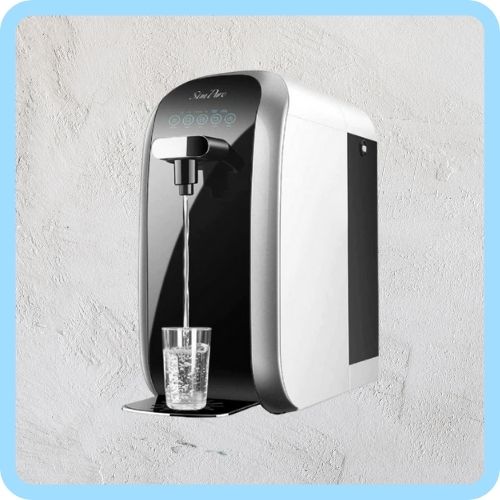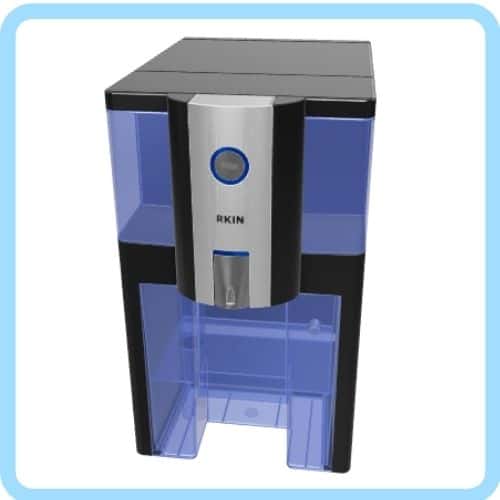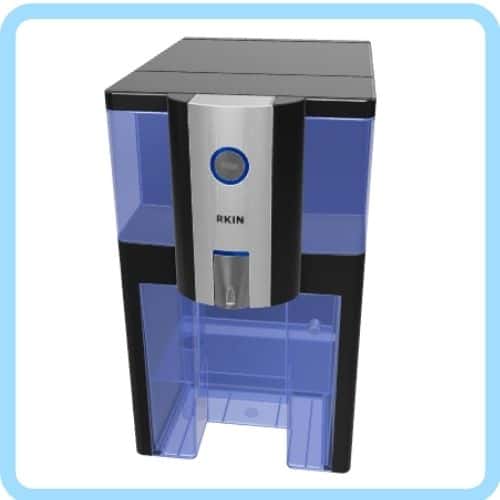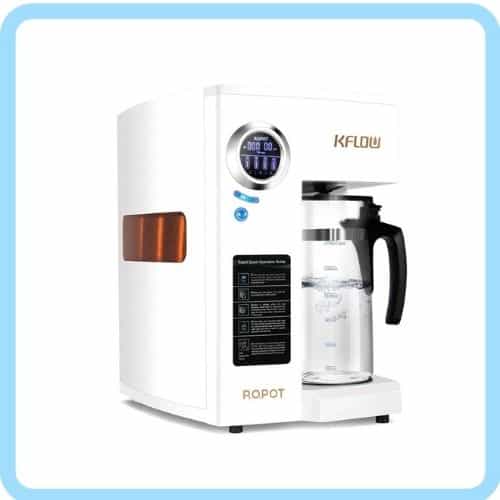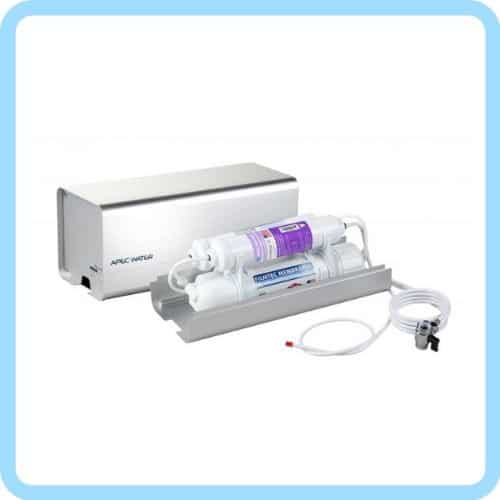The EPA has set out standards for at least 90 different contaminants in public drinking water including E-Coli and Salmonella. Good countertop RO water filters can remove all these.
There are two main types for you to consider:
- A standalone, zero-installation, manually-filled countertop unit
- A faucet-connected countertop unit
I’ve been using different kinds of water filters for the last seven years, after moving to a country with poor water quality. So I’m a bit of a water geek.
As being both economic, and eco-conscious is so important right now, I’m recommending the SimPure Y7 as my favorite countertop RO system. As an added bonus it’s also the best looking.
Before the Y7 was released, I recommended the AlcaPure Reverse Osmosis Countertop Water Filter by RKIN. But it’s still a great option for those who want re-mineralization.
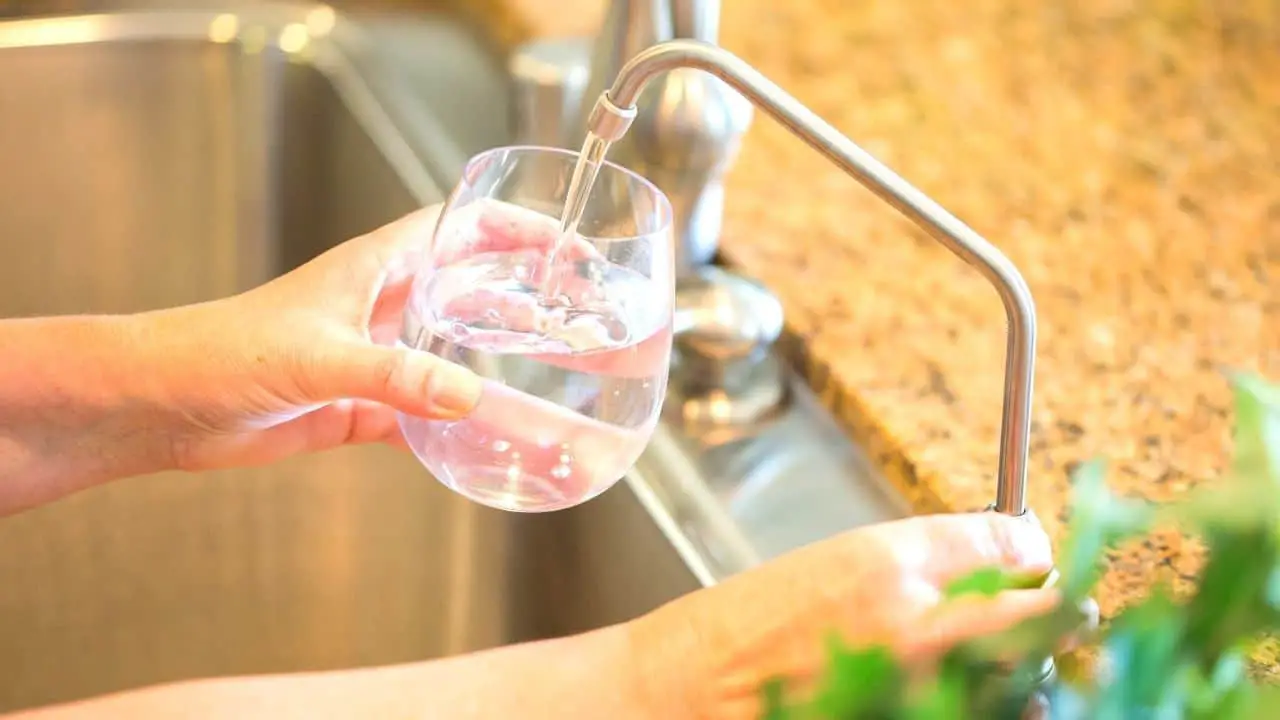
Our Top Five RO Water Filtration Systems
- SimPure Y7 – Best Designed & Most Water-Efficient
- AlcaPure by RKIN: – Best All-Rounder
- KFLOW (KFL-TDS-180) – Best for TDS Water Quality Monitoring
- Express Water EZRO5 – Best Budget Countertop RO
- APEC Water Systems RO CTOP PHC – Best Portable Countertop RO
Other countertop water purifier models have special features like UV lights or fast dispense buttons. So these may be more suitable for you.
Not yet sure that a reverse osmosis water filter system is right for you? Make sure to check out our advantages and disadvantages section, and our buyer’s guide.
Reviews: Top Five Countertop Reverse Osmosis Water Filters
Let’s get started with our top five and find out which is the best counter top water filter with RO.
SimPure Y7 Countertop Reverse Osmosis Water Filtration Purification System
Best Designed & Most Water-Efficient
- Stages: 3
- Water source: manual fill
- Installation: Zero
- Wastewater to Produced Water: 1:5 (estimated)
- Filter change: Every 12 months
- Capacity: 90 Gallons Per Day
- Dimensions: 15 x 18 x 8 inches
- Additional features: Instant dispense & UV Light
Our favorite countertop filter is the beautiful SimPure Y7. And there’s a good argument to say it’s the best countertop water purifier around. Design-wise it’s a knockout and a big improvement on the SimPure Y6. The sleek white design has an Apple iPhone-like aesthetic. Even the drain holes below the dispensing area look great!
It also wastes the least amount of water of all the models we reviewed. A wastewater ratio of 5:1 is pretty amazing. I wouldn’t worry about my water bills in the slightest if this was my everyday water filter.
As it only uses two filters, there’s less disposable plastic. So you’ll be reducing waste, saving money, and saving water too!
- Stage 1 & 2: Combined sediment & activate carbon pre-filter
- Stage 3: 0.0001 micron RO membrane
The SimPure Y7 won’t be for everyone as there is no post-filter. As mentioned this does cut down on waste. But you may need to compromise slightly on drinking water quality because there is no option for remineralization or an additional post-filter stage.
The Y7 also has a lot of added extras but loses the hot water feature of the SimPure Y6. The UV light adds an extra level of protection as it can kill some viruses and bacteria. And the instant dispense button can fill a glass in 15 seconds. Really useful for someone like me who is always rushing around in the mornings!
Owners of the Y7 love how easy it is to use and set up. On the downside, like some of the other models, people report it taking several flushes after setup to get the water to an optimum level. Not a big deal, as you only need to do this once.
AlcaPure Reverse Osmosis Countertop Water Filter by RKIN
Best All-Round Countertop RO System
- Stages: 4
- Water source: manual fill
- Installation: Zero
- Waste Water to Produced Water: 1:1
- Filter change: Every 12 months
- Capacity: 75 Gallons Per Day
- Dimensions: 9.5 x 14.5 x 16.25 inches
- Additional features: Choice of alkaline OR zero TDS post-filter
Other systems excel in one single area but the AlcaPure by RKIN is our best all-rounder as it’s above average in all areas. With the AlcaPure you’re getting value for money, efficiency, and a choice of post-filter.
The four-stage system includes two pre-filters and one post filter:
- Stage 1: Five-micron sediment filter
- Stage 2: Coconut shell activated carbon filter
- Stage 3: Reverse osmosis membrane
- Stage 4: Your choice of EITHER
- Alcapure Remineralization & Alkaline FIlter
- OnliPure Zero TDS Filter
It’s great to have the choice of the final stage filter. I’d go with the AlcaPure filter as I’m interested in the health benefits of calcium and magnesium in my drinking water. If you’re someone who wants zero Total Dissolved Solids (TDS) the OnliPure is also a great option.
Setting up the machine is as simple as unboxing, connecting the AC adapter, and then running two filtering cycles to flush the machine. I’m a renter who moves home pretty regularly. So I love that I can take the AlcaPure with me wherever I go (and without needing a bunch of tools too!)
The recovery rate is 1:1 meaning one wasted gallon to every gallon of produced water. This isn’t the best rate on our list (see the SimPure) but it is still very efficient. I hate wasting tap water, so this is a big deal for me.

The AlcaPure is also energy and water-efficient. It uses just 30W of power and has a recovery rate of 1:1. This means you won’t get a nasty shock on your next electricity bill.
The kitchen in my apartment is already packed with a kettle, toaster, and air fryer. So I love that it’s pretty small at just 9.5 x 14.5 x 16.25 inches. Of the manual-fill models reviewed, only the SimPure is smaller.
Users appreciate how easy the model is to install, the great-tasting drinking water, and the fast flow rate. Some comment that the design isn’t the greatest and that the price is more on the expensive end of the scale.
KFLOW Countertop Double RO Reverse Osmosis System, 4-Stage Water Filter System (KFL-TDS-180)
Best For TDS Monitoring
- Stages: 4
- Water source: manual fill
- Installation: Zero
- Waste Water to Produced Water: 1:2 (as little as 30% wasted)
- Filter change: RO filter every 24 months; pre & post filters every 12 months
- Capacity: 75 Gallons Per Day
- Dimensions: 17.5 x 16.25 x 14 inches’
- Additional features: Digital Monitoring System
The standout feature of this model is a digital monitoring system on the front of the machine. This not only records your TDS levels but can also tell you when your filters need changing. No more guesswork!
If you’re a data geek and want to keep records of your TDS levels, this is the perfect model for you.
This is another zero installation model. So just like the AlcaPure you just need to plug it in, fill it up, and start the flush cycle. Super simple.
This is technically a four-stage reverse osmosis system. But you’ll notice that there are only three filters with the third filter taking up two stages.
- Stage 1: polypropylene filter
- Stage 2: carbon block filter
- Stage 3 & 4: double reverse osmosis filter
The double reverse osmosis system blocks out over 1000 different common contaminants. So it’s super effective at reducing TDS in your tap water. I can’t taste the difference myself. But my girlfriend has much more sensitive taste buds. She really notices the improvement in the taste of low TDS drinking water.
KFLOW’s ROPOT looks nice too. It’s a much cleaner design than the AlcaPure, but can’t compete with the clean design of the SimPure. The KFlow is a good option if you want a high-quality countertop reverse osmosis water filtration system, but don’t like the look of the Alcapure.
Some users report the filters running out much quicker than the 24 months and 12 months stated by the manufacturer. So take this into consideration when considering your long term costs.
Express Water EZRO5 Countertop Reverse Osmosis Water Filtration System
Best Budget Countertop Reverse Osmosis Filter
- Stages: 4
- Water source: Faucet
- Installation: Screw onto faucet (20 minutes)
- Waste Water to Produced Water: 3:1
- Filter change: Every six months
- Capacity: 75 Gallons Per Day
- Dimensions: 13.25 x 6.5 x 14 inches
- Additional features: Fast-flow faucet included
This is the cheapest system we reviewed. Yet, it still offers great quality, clean drinking water. Despite a couple of minor inconveniences, the Express Water Counter Top Reverse Osmosis Water Filtration System is a great choice for people on a budget.
This model connects directly to your kitchen faucet but needs no technical knowledge. The installation manual is written in clear English with easy-to-follow pictures. I’d expect it to take most people between 15 and 20 minutes.
This is a four-stage filter:
- Stage 1: sediment filter
- Stage 2: granular carbon filter
- Stage 3: reverse osmosis membrane
- Stage 4: post activated carbon filter
The filters are really easy to replace and very cheap on a yearly basis. They sell a convenient one-year pack that includes 2 of each pre-filter and post-filter and one membrane. No need to worry about replacements for another year!
Personally, I don’t think this is the most attractive model we’ve reviewed. But its small size and low weight make up for that. So it’s good if you’re renting. I’d also consider this for future holidays in an RV.

Owners of this system agree that it’s fantastic value for money. But some are concerned with the high amount of wasted water.
Overall given the price, this Express Water EZRO5 is still an awesome deal.
APEC Water Systems RO CTOP PHc Alkaline Mineral Portable Countertop Reverse Osmosis Water Filter System
Best Portable Countertop RO System
- Stages: 4
- Water source: Faucet
- Installation: Screw onto faucet (20 minutes)
- Waste Water to Produced Water: 3:1 (estimated)
- Filter change: Every 12 months
- Capacity: 90 Gallons Per Day
- Dimensions: 18.5 x 12.2 x 10 inches
- Additional features: Alkaline post filter
The APEC RO CTOP is a high-end version of the Express Water EZRO5. It’s well-designed, sturdy, and comes with an aluminum protective case. This makes it much more durable for moving house and traveling. That’s why we’ve chosen it as the best portable reverse osmosis system for a countertop.

Like the other systems, it features four-stage filtration.
- Stage 1: five-micron sediment filter
- Stage 2: coconut shell activated carbon filter
- Stage 3: reverse osmosis membrane
- Stage 4: acidic water neutralizer
It’s recommended the pre-filters are replaced every six to eight months. The post-filter every six to twelve months. And the RO membrane every two to three years.
This will save you money in the long run compared to other systems that recommend changing all filters every six months or once a year. As you’ll only replace filters when they are worn out and avoid waste.
Users like the easy setup, portability, and the taste of the drinking water thanks to the calcium carbonate filter. One downside is you may need to flush the system five or six times before achieving optimal drinking water quality.
Advantages & Disadvantages of a Countertop RO Water Filter
Consider the pros and cons of installing a reverse osmosis system before deciding if it’s the right filter for your home.

Advantages
Effective filtration
Reverse osmosis filters remove the most common contaminants including sodium, copper, lead, chromium, and chloride from drinking water. They may also be effective for removing arsenic, fluoride, radium, sulfate, calcium, magnesium, potassium, nitrate, and phosphorous. [1]
The EPA has said that reverse osmosis is one of the most effective methods for “eliminating all disease-causing organisms and most chemical contaminants.” [2]
Speed
Reverse Osmosis systems tend to be much quicker at producing water than other methods.
For example, ceramic water filters like the Big Berkey can take around 1 hour per gallon to produce. Compare that to just 20 minutes per gallon for an average reverse osmosis water filtration system.
Easy to install
Opening the box of your RO water filtration system arrives in might be one of the toughest parts! Installation is so simple that anyone should be able to do it.
For standalone models
Find countertop space, fill the tank, and then connect the power.
For faucet-connected models
Find a space on your countertop. Then you’ll just need to connect the water supply and drainage.
Check out the guide on how to install a reverse osmosis water filter system below.

Portable & Good for Renters
Do you tend to move home regularly? Or does your landlord restrict which home improvements you’re allowed to carry out?
If so, countertop RO water filters are portable and can be moved to a new home relatively easily.
You’ll also leave no ‘footprint’ after installing the system as no construction is needed.
Good for The Environment
Each DAY over 60 million plastic bottles are sent to landfills or incinerators. [3]
Using a RO water filter instead of purchasing bottled filtered water is considerably cheaper and avoids all that waste!
Better tasting water for tea and coffee
Most specialty coffee shops will only use filtered water to improve the taste of their brews.
The Speciality Coffee Association of America (SCAA) recommends water should be free of odor, color, and chlorine; aand low in Total Dissolved Solids (TDS) and sodium [4]. RO water filters do a great job of meeting these standards.
The SCAA also recommends neutral water. But unfortunately, RO water will need additional filtering to control PH levels.
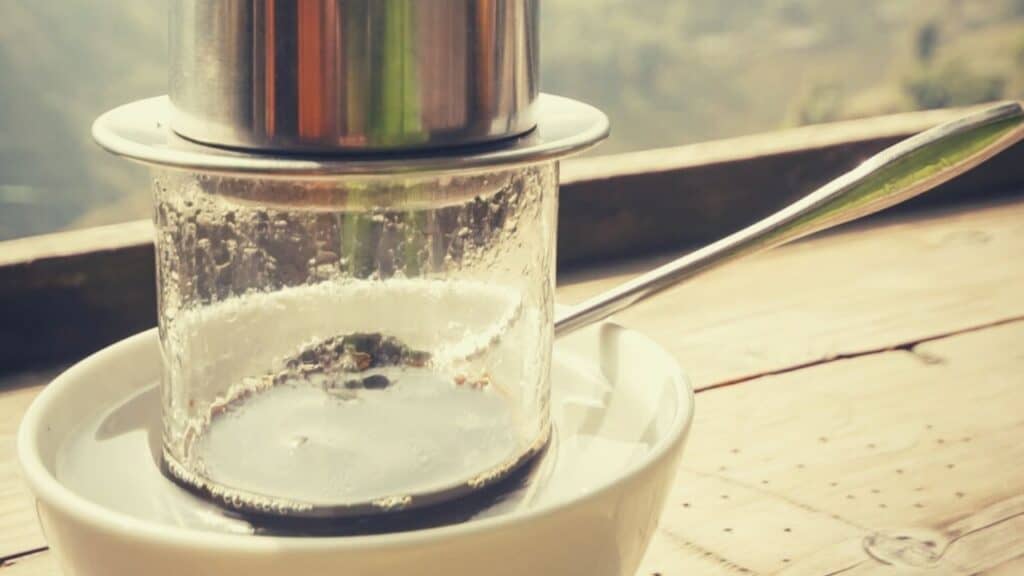
Disadvantages
Wastewater
The biggest drawback of installing a reverse osmosis system is the amount of tap water that is wasted.
In general, the ratio of wastewater to drinking water is 3:1. That means that for every gallon of drinking water produced, three gallons are wasted. [5]
And the amount of water wasted increases over time as the membrane gets older.
Disposal of Wastewater
As countertop reverse osmosis water generally wastes so much water, you’ll also need somewhere to dispose of it.
If your system has a drainage tank, then this will need emptying regularly.
Requires Countertop Space
All countertop water filters can take up a lot of countertop space. Especially when compared to a pitcher water filter. Consider this if you have a small kitchen.
Flat taste
This is a matter of preference. But some people find that these water filter systems produce flat-tasting water. This is because all minerals have been removed.

Unsuitable for Low Water Pressure
Some water filter models may recommend a minimum level of water pressure to operate correctly. This isn’t an issue if you are using a powered model with a pump.
Buyer’s Guide: How to Choose A Countertop Reverse Osmosis System
After considering the advantages and disadvantages, it should now be clear if an RO countertop water filter is right for your home. To make sure you choose the right system for your home’s water, purchase an accurate testing strip kit for lead and other contaminants.
Before you make your choice, consider the following:
Filtration Quality & No. of Stages
A reverse osmosis system will have at least four stages, but we’ve seen some with as many as six stages.
Generally, a countertop water filter will just have four stages. A sediment filter, an activated carbon filter, the actual reverse osmosis membrane, and a final post-filter carbon filter.
If you prefer the taste or health benefits of minerals in your water, consider a water filter with a remineralization stage.
Ease of set-up & installation
Some countertop reverse osmosis systems connect directly to your kitchen faucet. Make sure that your faucet is compatible and the correct connectors are included.
Other models simply need filling with tap water – no installation needed.
Installing and replacing filters on all the models we’ve used is as simple as twisting the filter into place.
Wasted Water Ratio (Or Recovery Rate)
As mentioned before, most RO water filter systems have a ratio of wasted water to produced water of 3:1.
More economical systems have a ratio of between 1:1 and 1.5:1 – but will generally be more expensive.
Your Home’s Water Usage
When buying a countertop reverse osmosis water system, be sure to check the Gallons Per Day (GPD).
You can generally expect a production rate of around 50% – 70% of the GPD rating listed.
For average households, we recommend a GPD rating of 50.
Water Pressure
For models that connect directly to your faucet, make sure that your water pressure is high enough to produce an adequate flow rate.
If you are considering a countertop reverse osmosis system that requires an electricity connection, then your home’s water pressure is not an issue.
Replacement filter frequency and costs
For most RO water filter models, pre-filters and post-filters should be changed every 12 months.
The RO membrane is usually replaced every two years.
Consider the compatible filters and their costs before making your final decision.
Available Countertop Space
Get out the tape measure! Check you have enough space for a countertop reverse osmosis water filter system.
The overall size and countertop footprint of these systems vary greatly.
How to Install A Countertop Reverse Osmosis System
Once you’ve purchased one of our best countertop reverse osmosis systems, you’ll need to install it.
For a standalone countertop reverse osmosis water filter system, this is as simple as hooking up the electricity and filling up the tank.
For systems that connect to a faucet, follow the following steps.
- Remove the aerator from your faucet.
- Attach the diverter valve.
- Check the connections are tight and ensure there are no leaks.
- Test the water filter system is working. The water flow may be slow at first.
- Flush the system, according to the manufacturer’s guidelines.
Your reverse osmosis water filter system is ready to go!
Alternatives to Countertop RO Systems
If you decide that a countertop reverse osmosis system is not for you, consider these alternative water filtration systems.

Under Sink Reverse Osmosis Systems
An RO water filter is a good alternative if you are sure you want reverse osmosis drinking water, but don’t have the available countertop space.
Undersink reverse osmosis systems also offer 4 stage filtration but can be hidden away in the cupboard under your sink. Perfect for small kitchens.
Ceramic Countertop Water Filter
Ceramic countertop filters are generally a cheaper option than a countertop RO system so are good for those on a budget.
They are effective at filtering out pathogens, bacteria, and larger matter like sediment. But they won’t reduce total dissolved solids (TDS) or minerals like a reverse osmosis system.
Pitcher Filters
Pitcher filters are space-saving and good for those on a budget.
If you’re just dipping your toes into water filtration a pitcher filter is a great way to get started with clean, filtered drinking water.
Frequently Asked Questions
Here are some of the most commonly asked questions. Feel free to use our contact page if you have any more questions you’d like answering.
What is a reverse osmosis water filter?
Without being technical, a reverse osmosis water filter is a semi-permeable membrane. The natural phenomenon of osmosis is reversed by applying energy to the process. Water is then pushed through the RO membrane. This removes salts, bacteria, and other organic matter.
How does a countertop RO system work?
Using the process of reverse osmosis (as described above), a countertop reverse osmosis filter connects to your kitchen faucet or is manually filled by the user.
The system then pushes the water through several stages of filters. These include pre-filters, an RO membrane, and sometimes a post-filter.
Which contaminants do RO countertop systems remove?
RO filters can remove thousands of contaminants. These include arsenic, barium cadmium, chromium, copper, cysts, fluoride, lead, and radium. Check out this site for a full list.
Do I need reverse osmosis if I have a whole house water filter system?
It’s not practical to install a whole-house RO filter. It would be extremely slow and expensive.
If you have a whole house water filter system, consider installing a reverse osmosis system IF you prefer the taste or health benefits.
Can reverse osmosis water be bad for you?
There is no evidence to suggest that reverse osmosis water is bad for you. Some evidence suggests that RO purified water removes some beneficial minerals. But most people should get these from a balanced diet anyway.
Berkey filter vs reverse osmosis. Which is better?
Berkey filters generally use carbon filtration and not reverse osmosis. Neither is ‘better’ it depends on your water quality and what you’re hoping to achieve.

